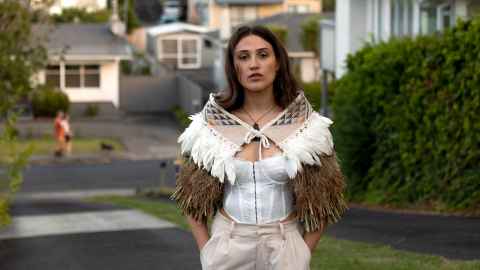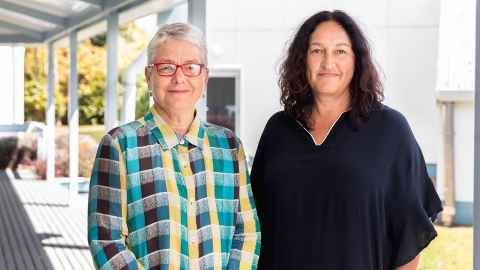Indigenising our universities: be Pākehā, be Māori
29 March 2023
Opinion: Te Kawehau Hoskins and Alison Jones explore the value of an evolving Treaty partnership to higher education. In the second of a three part series, they ask if inclusion policies can have unintended consequences.

The terms access, retention, participation, success, equity, diversity, culture and inclusion are common in universities. They have become key words in liberal rhetoric regarding Māori in the education system.
Strategies and policy papers share similar phrases: A culturally diverse academic student and staff body is desirable; to attract and retain Māori students, institutions seek to engage in inclusive and culturally responsive practices to ensure fair and equitable achievement for all, and particularly for priority groups.
These and similar equity phrases are ubiquitous in policy and spoken language. For more than three decades they have framed aspirations for the relationship between Māori and others in institutional discourse.
These terms define the central idea of ‘inclusion’ as the integration of formerly excluded and disadvantaged diverse groups and individuals into the patterns of achievement and success that, in the past, have been accessible mainly to the privileged.
By its very definition inclusion is not indigenisation. Some reasons are obvious. ‘Diversity’ (i.e., those to be included) is the phrase educational institutions use to refer to a range of ‘priority equity groups’ (formerly ‘disadvantaged’) including people with disabilities, ethnic minorities, immigrants, Pacific peoples, LGBTQI +, gender-diverse people, and those for whom English is a second language.
Māori are not an ‘equity’ group in diversity terms, because Māori are not simply an ethnic minority amongst diverse other ethnic minorities.
Rather, Māori have whakapapa rights based in their status as the Indigenous people of Aotearoa-New Zealand, rights that the Crown agreed to protect in 1840.
Any ‘equity’ framing for Māori stems from Article 3 of Te Tiriti o Waitangi, which pledges equality between the ‘tikanga’ (socio-cultural and political practices) of Indigenous Māori and those of the Queen’s subjects. This is a guarantee of tikanga Māori having mana or status alongside and equal to, but different from, those of the British, or the coloniser group.
Terms like ‘coloniser’ or ‘colonisation’ are far from straightforward. Given it has been established by the Waitangi Tribunal that (at least northern) rangatira, and thus their people, did not relinquish their sovereignty, or tino rangatiratanga, in February 1840, it is the case that Māori, as a sovereign people do not always recognise themselves as having been colonised.
So the indigenisation ideal inevitably confronts a further tension: a recognition of the fact of colonisation and the effects of its laws and practices alongside the assertion of continuous Māori sovereignty or non-colonisation. Both of these elements sit at the heart of indigenising the university.
Some argue that indigenisation is not the role of non-Maori. Non-Maori may involve themselves with processes of decolonisation, while Indigenous colleagues lead self-determining indigenisation work. ‘Decolonisation’ is a useful term, but it can turn attention yet again towards the coloniser and invite preoccupation with criticising the ‘colonised system’ rather than focusing on what might be possible.
Another common term in inclusion discourse is ‘culture’. The risk for any ‘ethnic minority’ is to be seen primarily in terms of culture. Scholars have argued that the term culture has become so heavily overused that it has lost its analytical utility. The dominance of the term ‘culture’ in relation to Māori can overshadow the intellectual, philosophical, and political dimensions of te ao Māori. This narrow focus can lead to ‘culturalism,’ an approach that considers all Indigenous issues primarily in terms of culture.
Te ao Māori’ and ‘mātauranga Māori’ refer not simply to a singular ‘traditional world’ or ‘traditional knowledge.’ They can refer to all contexts in which iwi Māori are/were engaged, yesterday, today and tomorrow.
Culture can also lead to the sin of homogenisation, when Māori, like everybody else, are extremely diverse tribally, politically, historically, culturally, personally as well as ethnically. Likewise, the terms ‘te ao Māori’ and ‘mātauranga Māori’ refer not simply to a singular ‘traditional world’ or ‘traditional knowledge.’
They can refer to all contexts in which iwi Māori are/were engaged, yesterday, today and tomorrow: from philosophical thought to photoshopping, from rugby to rocket science. There is no part of the modern world from which Māori thought and experience are isolated.
When educational institutions seek to ‘include’ Māori, the underlying intention is to help Māori, principally by successfully imparting the necessary skills they/we lack. The idea behind this deficit approach is that Māori need to gain the competence and confidence to achieve and access the social and economic rewards of the education system.
Few would disagree that relevant academic skills training is needed for all students, including Māori, particularly given their historical dispossession. The logic runs that problems for Māori are rooted in a range of conditions outside the university: from socio-economic status, poor transition from low decile schools, or the ongoing effects of colonisation.
But by framing Māori student access and achievement problems as coming from cultural displacement can let the university off the hook. Universities rarely see ourselves as a significant part of the problem, even when we have not identified or anticipated Māori expectations, and have not transformed in systemic ways to become places where Māori students and staff see themselves belonging.

Inclusion programme pitfalls
Two problems are evident with an inclusion discourse and programme. The first is that although imbued with care, love and good intentions, ultimately inclusion aims to better fit Māori to a relatively unchanged university environment.
Cultural inclusion can be seen in Māori language signage, Māori greetings, and even Māori design principles in new buildings and spaces. These are all positive, but te ao Māori is not limited to material signs, words, names, and designs. Research money and energy is spent on identifying inclusive practices such as ‘culturally responsive’ or ‘culturally sustaining’ pedagogies. More Māori language and culture make the institution more ‘culturally appropriate.’ Non-Māori staff are required to become ‘culturally competent’ in the quest to assist Māori.
At institutions following the path of inclusion, ‘cultural competency’ is seen largely in terms of non-Māori becoming more competent in understanding te ao Māori and te reo. At a truly indigenising organisation, cultural competency requires non-Māori to be more competent at being and understanding themselves: how/who they are ‘of this place,’ on this land, entangled in its histories and with the histories of their own people.
The pitfall of inclusion is that as Māori cultural knowledge and skills become more recognised and required, the recognition is accompanied by a request for Māori assistance: ‘Can you share with the class/group your knowledge about the marae/Māori language/a Māori perspective, please?’
Māori colleagues and students are seen primarily as a helpful resource rather than as individuals who may or may not know much about te ao Māori, who are from iwi other than the ones being discussed, who are faced with the impossible request to ‘speak for all Māori,’ or who may or may not want to share their knowledge.
Impulses for cultural inclusion can be blind to colonialism and the power relationships in the institution, power that expresses itself as an invitation to Māori to join in that is conditional.
A second problem lies in inclusive institutional change. An inclusion model seeks cultural change in an educational organisation by making it more accessible and comfortable to diverse groups, with Māori as a priority. But the burden of change tends to fall on individual Indigenous students and staff members. Not only must they assist their non-Māori colleagues to become more knowledgeable about Māori, but they must change by becoming something ‘more’ than they were: more ‘skilled,’ more ‘included,’ more ‘successful.’
On the face of it, this is a good thing. Yet too often Māori students report that they must ‘fit in,’ and ‘leave their full selves at the door’ to be successful. They have to change as the focus shifts to the problems of Māori rather than those of the institution.
Indigenisation keeps a firm eye on institutional change; the university becomes ‘more Māori.’ Success on this model comes with evidence. Does the university have more (permanent, high status) Māori staff, and students? Does it teach more Māori knowledge in more Māori ways? Is the university a place where Māori assumptions and priorities are supported and resourced? Is this a place where people at all levels engage with each other on the basis of friendship and individual care (whanaungatanga and manaakitanga)? Has the university earned recognition as a place that produces and has become a respected storehouse of mātauranga, which is universally valued as a taonga (treasure)?
As we have suggested, the institution being ‘more Māori,’ does not mean simply that there are more Māori language signs, more Māori names for units, and a karakia at every meeting. It does not mean that non-Māori individuals in the organisation try to become ‘more Māori.’ Rather, it is an invitation for non-Māori to understand their own identities in relation to Māori, to history, to this whenua, and to Te Tiriti o Waitangi in its modern status as a foundational guide to our work in this country.
For Pākehā, indigenising the university is an invitation to ‘be Pākehā,’ that is, to orient towards Māori with undemanding attention. For some Pacific peoples it is an opportunity to think through the whakapapa relationship with Māori and with Te Tiriti. For immigrants from Britain, India, China, Afghanistan and elsewhere, it is an invitation to consider who you are in this place, at this time in history, in relation to the Indigenous people and New Zealand’s historic agreements.
In short, from the perspective of a Māori member of the organisation, an inclusion model asks me to change – thus contributing to the improved culture of the institution – while an indigenising organisation is where a Māori member can be Māori.
This takes us back to the simplest definition of the word ‘māori,’ which can be translated as ‘ordinary, everyday, usual.’ Can the university become māori for Māori communities?
Associate Professor Te Kawehau Hoskins is Pro Vice-Chancellor Māori, and Alison Jones is a Professor at Te Puna Wānanga, Faculty of Education and Social Work, at Waipapa Taumata Rau, University of Auckland.
A series of three articles adapted by Gilbert Wong from Indigenous Inclusion and Indigenising the University, by Te Kawehau Hoskins and Alison Jones, New Zealand Journal of Educational Studies.
This article reflects the opinion of the authors and not necessarily the views of Waipapa Taumata Rau, University of Auckland.
Contact for republication: Gilbert Wong, gilbert.wong@auckland.ac.nz